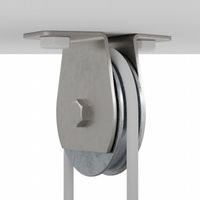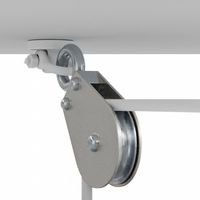Call +(254) 703 030 000 / 751 483 999 / 721 704 777
- Home
- Material Handling
- Lifting Pulling Positioning
- Lifting Rigging Hardware
- Pulley Blocks Sheaves
.....Read More
Frequently Asked Questions
What is the difference between a pulley block and a sheave?
A pulley block and a sheave are components used in lifting and rigging systems, but they serve different functions and have distinct characteristics.
A pulley block is a complete assembly that includes one or more sheaves housed within a frame or shell. It is designed to change the direction of a rope or cable and can also provide a mechanical advantage when used in systems like block and tackle. Pulley blocks are often used in lifting applications, such as cranes or hoists, where they help distribute weight and reduce the effort needed to lift heavy loads. The block typically includes features like hooks, shackles, or swivels for attachment to other equipment.
A sheave, on the other hand, is a single component within a pulley block. It is the wheel or roller with a grooved rim that guides the rope or cable. The groove helps keep the rope aligned and prevents it from slipping off. Sheaves can be made from various materials, including metal, plastic, or composite, depending on the application and load requirements. They are crucial for minimizing friction and wear on the rope, ensuring smooth operation.
In summary, the primary difference is that a pulley block is a complete unit that includes one or more sheaves, while a sheave is the individual wheel component within the block. Pulley blocks are used for lifting and mechanical advantage, whereas sheaves are essential for guiding and supporting the rope or cable within the block.
How do you calculate the mechanical advantage of a pulley system?
To calculate the mechanical advantage (MA) of a pulley system, follow these steps:
1. **Identify the Type of Pulley System**: Determine if the system is a single fixed pulley, a single movable pulley, or a combination of both (block and tackle).
2. **Count the Number of Supporting Ropes**: For a simple pulley system, the mechanical advantage is equal to the number of rope segments supporting the load. This includes all ropes that directly contribute to lifting the load, excluding the rope segment where the effort is applied.
3. **Fixed Pulley**: A single fixed pulley changes the direction of the force applied but does not provide mechanical advantage. MA = 1.
4. **Movable Pulley**: A single movable pulley provides a mechanical advantage of 2, as it effectively halves the effort needed to lift the load. MA = 2.
5. **Block and Tackle System**: In a block and tackle system, count all the rope segments supporting the load. The mechanical advantage is equal to this count. For example, if there are four supporting ropes, MA = 4.
6. **Calculate Using Force and Load**: Alternatively, calculate MA by dividing the load force by the effort force. MA = Load Force / Effort Force.
7. **Consider Friction**: In real-world applications, account for friction, which reduces the effective mechanical advantage. The ideal MA assumes no friction.
By following these steps, you can determine the mechanical advantage of any pulley system, allowing you to understand how much the system reduces the effort needed to lift a load.
What materials are pulley blocks and sheaves typically made from?
Pulley blocks and sheaves are typically made from a variety of materials, each chosen for specific properties that suit different applications. Common materials include:
1. **Steel**: Known for its strength and durability, steel is often used in heavy-duty applications where high load capacity is required. It is resistant to wear and can handle harsh environments.
2. **Stainless Steel**: Offers similar strength to regular steel but with added corrosion resistance, making it ideal for marine and outdoor applications where exposure to moisture and salt is a concern.
3. **Aluminum**: Lightweight and resistant to corrosion, aluminum is used in applications where weight is a critical factor. It is not as strong as steel but provides a good balance of strength and weight.
4. **Bronze**: Often used in sheaves, bronze provides excellent wear resistance and is self-lubricating, which reduces maintenance needs. It is suitable for applications involving high friction.
5. **Nylon**: A type of plastic, nylon is lightweight and offers good resistance to wear and corrosion. It is often used in applications where noise reduction is important, as it operates more quietly than metal.
6. **Cast Iron**: Known for its excellent machinability and wear resistance, cast iron is used in applications where cost is a concern and the environment is not overly harsh.
7. **Composite Materials**: These are increasingly used for their strength-to-weight ratio and resistance to environmental factors. Composites can be tailored to specific needs, offering versatility in design.
Each material offers distinct advantages and is selected based on factors such as load capacity, environmental conditions, cost, and specific application requirements.
How do you install a pulley block for lifting?
1. **Select the Right Pulley Block**: Choose a pulley block that matches the weight and type of load you intend to lift. Ensure it has the appropriate load capacity and is suitable for the environment.
2. **Gather Necessary Tools and Equipment**: You will need a pulley block, rope or cable, a secure anchor point, shackles or hooks, and safety gear like gloves and helmets.
3. **Inspect the Equipment**: Check the pulley block, rope, and all components for any signs of wear, damage, or defects. Replace any compromised parts.
4. **Identify a Secure Anchor Point**: Find a strong, stable structure to attach the pulley block. This could be a beam, ceiling joist, or a specially designed lifting frame.
5. **Attach the Pulley Block**: Use shackles or hooks to securely attach the pulley block to the anchor point. Ensure all connections are tight and secure.
6. **Thread the Rope or Cable**: Pass the rope or cable through the pulley wheel(s). Ensure it is properly seated in the groove and free of twists or knots.
7. **Secure the Load**: Attach the load to the rope or cable using appropriate lifting slings or hooks. Ensure the load is balanced and securely fastened.
8. **Test the Setup**: Before lifting the actual load, perform a test lift with a lighter weight to ensure everything is functioning correctly and safely.
9. **Lift the Load**: Gradually apply force to the rope or cable to lift the load. Maintain control and ensure the load remains stable throughout the lift.
10. **Monitor and Adjust**: Continuously monitor the setup for any signs of stress or instability. Make adjustments as necessary to maintain safety.
11. **Lower the Load Safely**: When lowering, do so slowly and steadily to avoid sudden drops or swings.
12. **Disassemble and Store**: After use, disassemble the setup and store all components properly for future use.
What are the safety considerations when using pulley blocks and sheaves?
1. **Load Capacity**: Ensure the pulley block and sheave are rated for the load being lifted. Exceeding the load capacity can lead to equipment failure.
2. **Inspection**: Regularly inspect for wear, corrosion, cracks, or deformation. Check for smooth operation and ensure that the sheave rotates freely.
3. **Alignment**: Ensure proper alignment of the sheave with the load to prevent side loading, which can cause excessive wear or failure.
4. **Rope Compatibility**: Use the correct type and size of rope or cable. The rope should fit the groove of the sheave properly to avoid slippage or damage.
5. **Secure Attachment**: Ensure that the pulley block is securely attached to a stable anchor point. Use appropriate shackles or hooks rated for the load.
6. **Lubrication**: Regularly lubricate moving parts to reduce friction and wear, ensuring smooth operation.
7. **Environmental Conditions**: Consider environmental factors such as temperature, moisture, and corrosive elements that may affect the equipment's integrity.
8. **Training**: Ensure that operators are trained in the proper use and safety procedures for pulley systems.
9. **Load Control**: Maintain control of the load at all times. Avoid sudden movements or jerks that can cause the load to swing or the system to fail.
10. **Personal Protective Equipment (PPE)**: Use appropriate PPE, such as gloves and helmets, to protect against potential hazards.
11. **Emergency Procedures**: Have emergency procedures in place in case of equipment failure or accidents.
12. **Regulatory Compliance**: Follow all relevant safety standards and regulations, such as those from OSHA or other local authorities.
13. **Signage and Warnings**: Clearly mark areas where pulley systems are in use and provide warnings about potential hazards.
How do you maintain and lubricate pulley blocks and sheaves?
To maintain and lubricate pulley blocks and sheaves, follow these steps:
1. **Inspection**: Regularly inspect the pulley blocks and sheaves for signs of wear, corrosion, or damage. Check for cracks, deformation, or sharp edges that could damage the rope or cable.
2. **Cleaning**: Clean the sheaves and blocks to remove dirt, debris, and old lubricant. Use a wire brush or compressed air for thorough cleaning. Ensure the grooves are free from any obstructions.
3. **Lubrication**: Apply a suitable lubricant to the sheave bearings and the groove. Use a high-quality grease or oil that is compatible with the materials and environmental conditions. Ensure the lubricant is applied evenly to prevent friction and wear.
4. **Check Alignment**: Ensure the sheaves are properly aligned with the load path. Misalignment can cause uneven wear and reduce the efficiency of the system.
5. **Tension and Load**: Verify that the tension and load on the pulley system are within the recommended limits. Overloading can cause excessive wear and potential failure.
6. **Rope/Cable Inspection**: Regularly inspect the rope or cable for wear, fraying, or damage. Replace if necessary to prevent accidents and ensure smooth operation.
7. **Rotation Check**: Ensure the sheaves rotate freely without any binding or resistance. This indicates proper lubrication and alignment.
8. **Environmental Considerations**: Consider the operating environment. In harsh conditions, such as marine or dusty environments, more frequent maintenance and lubrication may be necessary.
9. **Record Keeping**: Maintain a log of inspections, maintenance, and lubrication activities. This helps in tracking the condition and performance of the pulley system over time.
10. **Professional Maintenance**: Engage professional services for periodic detailed inspections and maintenance, especially for complex or critical systems.
What are the common applications of pulley blocks and sheaves in industry?
Pulley blocks and sheaves are essential components in various industrial applications due to their ability to lift, lower, and move heavy loads efficiently. Here are some common applications:
1. **Construction**: Pulley systems are used in cranes and hoists to lift heavy materials like steel beams, concrete blocks, and other construction materials to significant heights, facilitating building and infrastructure development.
2. **Manufacturing**: In manufacturing plants, pulley blocks are used in conveyor systems to transport products along assembly lines, improving efficiency and reducing manual labor.
3. **Mining**: Pulley systems are crucial in mining operations for lifting and lowering equipment, ore, and other materials from deep underground, enhancing safety and productivity.
4. **Shipping and Maritime**: On ships and docks, pulley blocks are used to handle cargo, adjust sails, and manage anchor systems, ensuring smooth and efficient maritime operations.
5. **Theater and Entertainment**: In theaters, pulley systems are used to move scenery, curtains, and lighting equipment, allowing for dynamic stage changes and effects.
6. **Elevators and Lifts**: Pulley blocks are integral to the operation of elevators and lifts, providing the mechanical advantage needed to move cabins smoothly between floors.
7. **Forestry and Logging**: In forestry, pulley systems are used to haul logs and other heavy materials, facilitating transportation and processing.
8. **Aerospace and Defense**: Pulley blocks are used in aircraft and military equipment for various applications, including control systems and load management.
9. **Agriculture**: In agricultural settings, pulley systems help in operating machinery and equipment, such as grain elevators and irrigation systems.
10. **Rescue Operations**: Pulley blocks are used in rescue operations to lift and move injured individuals or heavy debris, providing critical support in emergency situations.


